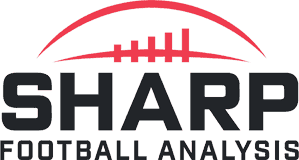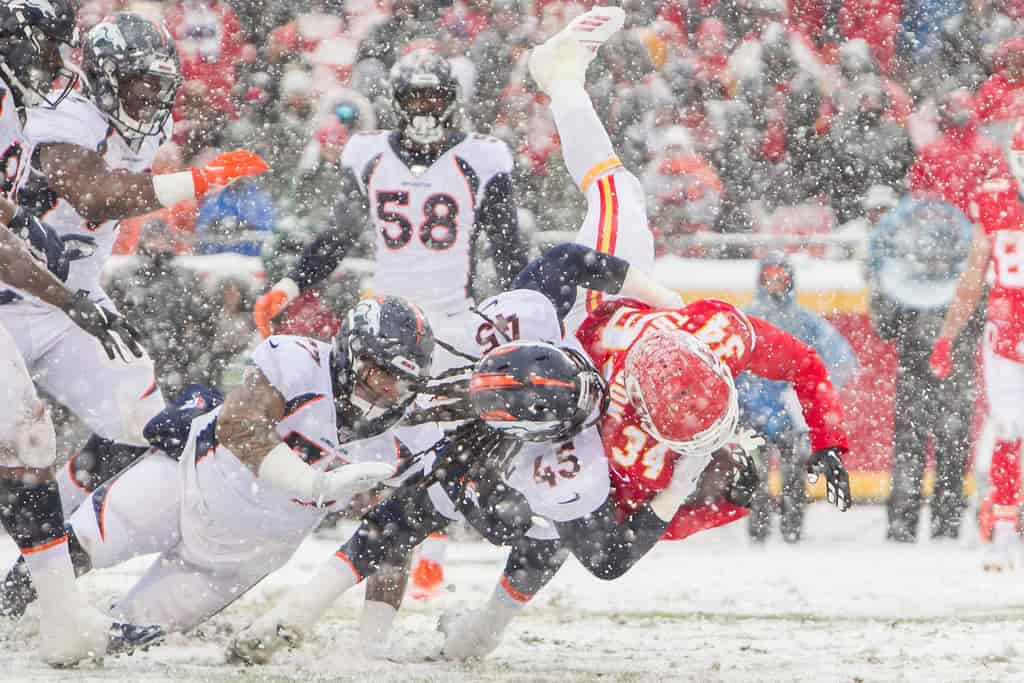One thing casual sports bettors often overlook is how the weather can impact NFL betting outcomes. Whether it's high winds or frigid temperatures, the weather has a measurable effect on football betting, especially over/under bets and player props.
Below, we’ll discuss how to account for weather conditions when placing NFL bets.
Weather Factors that Can Impact NFL Betting
The NFL has some stadiums with domes, which shield games from inclement weather. However, only seven NFL stadiums have fixed or retractable roofs. The rest are outdoor stadiums.
There are three main weather categories that can affect football games:
- Precipitation, including rain and snow
- Wind
- Temperature
It’s important to keep in mind that these effects can be compounded, having a greater impact on the game and how you should wager.
How Precipitation Affects NFL Games
Precipitation, in its various forms, is the first thing people tend to think about when they consider NFL weather conditions.
It’s hard to measure intangibles such as a quarterback's ability to throw accurate passes during a snowy game or the psychological effect that heavy rain can have on playmakers. However, any weather factor that affects the game can, in turn, impact player performance and things like a game's pace, scoring, and offensive/defensive strategies.
Precipitation is often accompanied by wind, so it’s important to factor in both. And when it’s both windy and rainy, for example, expect things to get even more complicated and messy, especially for offenses.
Snow
The biggest weather concern for NFL betting is snow. NFL games with heavy snowfall show a 25% decrease in points scored. That's because snow affects visibility, traction, and grip on the ball (leading to an increase in turnovers, especially fumbles).
Game data shows that light snow doesn't have nearly as much of an impact on games. This makes sense since light snow is the least obtrusive form of precipitation. Games that took place in light snow showed only a 2% drop on average in points scored.
In general, snow does have a significant impact on field goal kicking, though. Games that have taken place in snow have a 76% field goal percentage (down 7% from the league average of 83% success rate on field goal attempts).
It’s also important to note that many coaches shorten the acceptable range of kicking field goals if there’s snowy weather. This means most field goals tried in snowy weather come from a closer range, and still, there are more misses.
Rain
On average, a quarterback’s passing completion percentage drops by 12% in rainy weather. Unsurprisingly, a wet ball leads to lower throw accuracy and catch success rates.
On the other hand, made field goal percentages actually increase from 83% to 85%. However, this is a bit misleading, as teams tend to attempt shorter field goals during rainy games. When you compare field goals from the same distance in the rain vs. normal conditions, the success rate decreases by 2%.
According to another NFL kicking study, the typical 40-yard field goal in the NFL has an 86% chance, while the same field goal has a likelihood of 82% in the rain. A 50-yarder goes from 71% to 65%.
Wind
Wind can significantly affect passing and kicking. The average windspeed for an outdoor NFL game is 7 mph. This level of wind is negligible, but as it increases, passing and kicking percentages decrease substantially.
At around 15 mph, a difference begins to show, with a 3% drop in field-goal success rate. When windspeed surpasses 20 mph, the effects are much more severe, and data shows a significant drop-off in both passing and kicking percentages.
Like precipitation, coaches factor these weather effects into pre-game and in-game decision-making. On a windy day, a savvy coach will shorten their potential range for field goal tries, stick more to the ground game (more predictable), and hit teams with more dinks and dunks (less air time for the ball to be affected by wind).
Temperature
Temperature as a factor on its own is fairly straightforward. Data for extreme temperatures shows a drop-off in points scored.
Games with temperatures higher than 85°F or lower than 25°F show an 8% reduction in points scored. On that same note, games played in weather between 25°F and 50°F show a 5% drop-off in average scoring rates.
How to Factor in Weather When Placing NFL Bets
Always factor weather conditions into your NFL betting strategies. This will help you predict the outcome of football matches to the best of your abilities.
Rain and Snow Typically Mean Lower Scoring
Games with extreme weather tend to be lower scoring, so when it comes to player props and totals, make sure to adjust your football predictions accordingly. It's also important to know that sportsbooks factor in weather conditions when creating lines, so if there's a chance of snow, rain, or heavy wind, that will already be baked into the odds.
On average, light rain or snow leads to a combined 2 points fewer scored, while moderate rain leads to 4 fewer points on average, and moderate snow leads to 6 fewer. Heavy rain and snow have an even larger effect, reducing scoring by 6 points and 10 points, respectively.
Expect Lower Player Production (but not always)
Passing and field goal production rates fall in windy or rainy weather. So you can expect lower points and lower offensive player production, especially for key skill positions like quarterback and wide receiver, which require much more fidelity. In fact, drops increase by as much as 6% depending on the amount of snow or rain. Your NFL prop bets should reflect this.
However, lower production isn't always the case. For example, a running back could be in line for a huge day if a team decides to pound the rock on the ground, which can be a great way to negate bad weather conditions. Also, tackling ability seems to fall sharply during rainy or snowy games as players struggle to grasp slippery ball carriers.
Use Weather Conditions to Get a Betting Edge
In short, sports bettors need to be aware of the forecasted weather before NFL games, especially if it is likely to be extreme. If you can move fast, you can get better odds before NFL betting apps adjust their lines to account for the weather forecast.
Acting fast and capitalizing on weather changes heading into NFL games is a good way to get a betting edge and boost your CLV.


